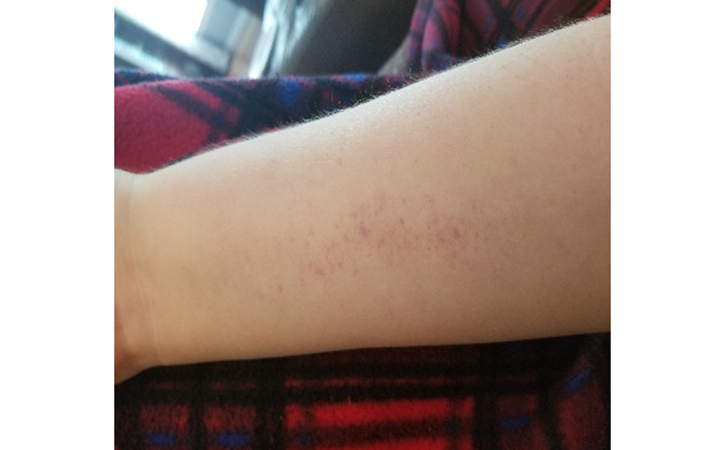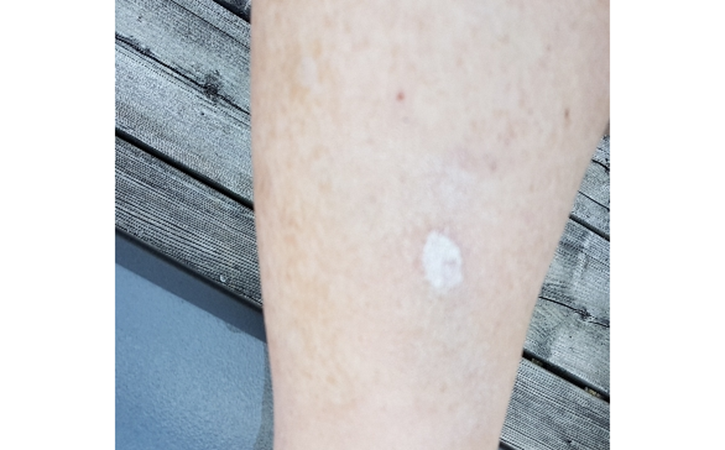Lichen Simplex
Lichen simplex chronicus (LSC) (also known as neurodermatitis) is thickening & leathery of the skin with variable scaling that arises secondary to repetitive scratching or rubbing. Called neurodermatitis because it’s considered a neurological skin disorder fueled by the itch-scratch cycle. Lichen simplex chronicus is not a primary process. A person senses pruritus in a specific area of skin (with or without underlying pathology) and causes mechanical trauma to the point of lichenification.

It may develop several itchy spots, typically on the neck, wrists, forearms, legs or anal region. It is not life-threatening or contagious. But the itching can be so intense or recurrent that it disrupts sleep, sexual function and quality of life.
Breaking the itch-scratch cycle of neurodermatitis is challenging, and neurodermatitis is usually a lifelong condition. Treatment success depends on resisting the urge to rub or scratch the affected areas.
Lichen simplex chronicus was more common in Asians and African Americans. The appearance of lesions on darker skin sometimes shows follicular prominence. Secondary pigmentary alterations are also more severe in individuals with darker skin.
Lichen simplex chronicus is observed more commonly in females than in males. Lichen nuchae is a form of lichen simplex that occurs on the midposterior neck and is observed almost exclusively in women.
Lichen simplex chronicus occurs mostly in mid-to-late adulthood, with highest prevalence in persons aged 30-50 years.
The medial aspect of the ankle, the back of the scalp, the extensor aspects of the forearms, the wrists and the genitalia are predisposed to this disorder. The condition is extremely itchy and patients complain bitterly about the intense local irritation. The lesions are characteristically raised, irregular, red plaques with well-defined margins, which have exaggerated skin markings (lichenification) over the scaling surface. If the itching is persistent and intense and the resultant scratching vigorous, the affected sites may become very thickened, raised and excoriated.
The cause of lichen simplex chronicus (neurodermatitis) is unknown, but certain triggers, like: an insect bite and stress seem to play a role. The persistent rubbing and scratching that characterize the condition may begin with something that simply irritates the skin, like: tight clothing or a bug bite. As rub or scratch the area, it gets itchier. The more scratch, the more it itches.



In some cases, neurodermatitis is associated with chronic skin conditions, like: dry skin, eczema or psoriasis. Stress and anxiety can trigger itching too.
Long-term exposure to street traffic exhaust has been associated with an increase in the frequency of childhood skin diseases, including lichen simplex chronicus.
Some reserve the analyze of lichen simplex for patients who have no known predisposing skin disorder. The term secondary lichenification has been used if the eruption is initiated by a primary dermatosis.
Treatment is aimed at controlling the itching, preventing scratching and addressing underlying causes.
Corticosteroids: It has anti-inflammatory properties and cause profound and varied metabolic effects. They modify the body’s immune response to diverse stimuli. They decrease pruritus, thin lichenification, and reduce inflammation.
Clobetasol is a class I superpotent topical steroid; it suppresses mitosis and increases the synthesis of proteins that decrease inflammation and cause vasoconstriction.
Betamethasone dipropionate cream 0.05% is for inflammatory dermatoses responsive to steroids. It decreases inflammation by suppressing the migration of polymorphonuclear leukocytes and reversing capillary permeability. It affects the production of lymphokines and has an inhibitory effect on Langerhans cells.
Fluocinolone is a medium potency topical corticosteroid that inhibits cell proliferation; it also is immunosuppressive, antiproliferative, and anti-inflammatory. Flurandrenolide tape (4 mcg/cm2; Cordran tape) combines a topical steroid with the benefits of occlusion and is classified as a group I (potency) preparation.
Anti-itch medicated creams: If corticosteroid cream isn’t helping, doctor may prescribe a stronger corticosteroid or a nonsteroidal anti-itch product. A calcineurin inhibitor (tacrolimus) ointment may help if the vulva is involved.
Corticosteroid injections: Doctor may inject corticosteroids directly into the affected skin to help it heal.
Medicine to ease itching: Prescription antihistamines help relieves itching with neurodermatitis. Some of these drugs may cause drowsiness and help with alleviating scratching while sleep.
Anti-anxiety drugs: Because anxiety and stress can trigger neurodermatitis, anti-anxiety drugs may help prevent the itchiness.
Medicated patches: For stubborn itching, doctor may suggest topical lidocaine 5 percent or capsaicin 8 percent patches.
Light therapy: Exposing the affected skin to particular types of light is sometimes helpful.
Psychotherapy: Talking with a counselor can help learn how emotions and behaviors can fuel or prevent itching and scratching.
If itching persists despite treatment, doctor may suggest a nontraditional approach. For example, some people whose symptoms didn’t improve with corticosteroid use did report success with the following treatments.
OnabotulinumtoxinA (Botox) injection: This technique may reduce itching and clear up rough skin patches.
An oral drug to ease the compulsion to pick and scratch: An oral drug called N-acetylcysteine has been help some people with picking and scratching disorders and may be of help to people with neurodermatitis.
See a doctor if:
- Consultation with a dermatologist in severe cases requiring more than topical treatments or to facilitate patch testing.
- Skin becomes painful or looks infected and have a fever,
- Consultation with an allergist may be considered in individuals with multisystemic atopic symptoms. When the itch prevents from sleeping or focusing on daily routines,
- Consultation with a psychiatrist may be considered, given the association with underlying depressive and anxiety disorders.
- Oxford hand Book of medical Dermatology
- ABC Of Dermatology
- Clinical Dermatology
- Roxburgh’s common skin diseases
- Andrew’s Diseases of the skin.
Lichen Simplex
TUI - Tibot Urgency Index


Lichen simplex chronicus (LSC) (also known as neurodermatitis) is thickening & leathery of the skin with variable scaling that arises secondary to repetitive scratching or rubbing. Called neurodermatitis because it’s considered a neurological skin disorder fueled by the itch-scratch cycle. Lichen simplex chronicus is not a primary process. A person senses pruritus in a specific area of skin (with or without underlying pathology) and causes mechanical trauma to the point of lichenification.



It may develop several itchy spots, typically on the neck, wrists, forearms, legs or anal region. It is not life-threatening or contagious. But the itching can be so intense or recurrent that it disrupts sleep, sexual function and quality of life.
Breaking the itch-scratch cycle of neurodermatitis is challenging, and neurodermatitis is usually a lifelong condition. Treatment success depends on resisting the urge to rub or scratch the affected areas.
Lichen simplex chronicus was more common in Asians and African Americans. The appearance of lesions on darker skin sometimes shows follicular prominence. Secondary pigmentary alterations are also more severe in individuals with darker skin.
Lichen simplex chronicus is observed more commonly in females than in males. Lichen nuchae is a form of lichen simplex that occurs on the midposterior neck and is observed almost exclusively in women.
Lichen simplex chronicus occurs mostly in mid-to-late adulthood, with highest prevalence in persons aged 30-50 years.
The medial aspect of the ankle, the back of the scalp, the extensor aspects of the forearms, the wrists and the genitalia are predisposed to this disorder. The condition is extremely itchy and patients complain bitterly about the intense local irritation. The lesions are characteristically raised, irregular, red plaques with well-defined margins, which have exaggerated skin markings (lichenification) over the scaling surface. If the itching is persistent and intense and the resultant scratching vigorous, the affected sites may become very thickened, raised and excoriated.
The cause of lichen simplex chronicus (neurodermatitis) is unknown, but certain triggers, like: an insect bite and stress seem to play a role. The persistent rubbing and scratching that characterize the condition may begin with something that simply irritates the skin, like: tight clothing or a bug bite. As rub or scratch the area, it gets itchier. The more scratch, the more it itches.



In some cases, neurodermatitis is associated with chronic skin conditions, like: dry skin, eczema or psoriasis. Stress and anxiety can trigger itching too.
Long-term exposure to street traffic exhaust has been associated with an increase in the frequency of childhood skin diseases, including lichen simplex chronicus.
Some reserve the analyze of lichen simplex for patients who have no known predisposing skin disorder. The term secondary lichenification has been used if the eruption is initiated by a primary dermatosis.
Treatment is aimed at controlling the itching, preventing scratching and addressing underlying causes.
Corticosteroids: It has anti-inflammatory properties and cause profound and varied metabolic effects. They modify the body’s immune response to diverse stimuli. They decrease pruritus, thin lichenification, and reduce inflammation.
Clobetasol is a class I superpotent topical steroid; it suppresses mitosis and increases the synthesis of proteins that decrease inflammation and cause vasoconstriction.
Betamethasone dipropionate cream 0.05% is for inflammatory dermatoses responsive to steroids. It decreases inflammation by suppressing the migration of polymorphonuclear leukocytes and reversing capillary permeability. It affects the production of lymphokines and has an inhibitory effect on Langerhans cells.
Fluocinolone is a medium potency topical corticosteroid that inhibits cell proliferation; it also is immunosuppressive, antiproliferative, and anti-inflammatory. Flurandrenolide tape (4 mcg/cm2; Cordran tape) combines a topical steroid with the benefits of occlusion and is classified as a group I (potency) preparation.
Anti-itch medicated creams: If corticosteroid cream isn’t helping, doctor may prescribe a stronger corticosteroid or a nonsteroidal anti-itch product. A calcineurin inhibitor (tacrolimus) ointment may help if the vulva is involved.
Corticosteroid injections: Doctor may inject corticosteroids directly into the affected skin to help it heal.
Medicine to ease itching: Prescription antihistamines help relieves itching with neurodermatitis. Some of these drugs may cause drowsiness and help with alleviating scratching while sleep.
Anti-anxiety drugs: Because anxiety and stress can trigger neurodermatitis, anti-anxiety drugs may help prevent the itchiness.
Medicated patches: For stubborn itching, doctor may suggest topical lidocaine 5 percent or capsaicin 8 percent patches.
Light therapy: Exposing the affected skin to particular types of light is sometimes helpful.
Psychotherapy: Talking with a counselor can help learn how emotions and behaviors can fuel or prevent itching and scratching.
If itching persists despite treatment, doctor may suggest a nontraditional approach. For example, some people whose symptoms didn’t improve with corticosteroid use did report success with the following treatments.
OnabotulinumtoxinA (Botox) injection: This technique may reduce itching and clear up rough skin patches.
An oral drug to ease the compulsion to pick and scratch: An oral drug called N-acetylcysteine has been help some people with picking and scratching disorders and may be of help to people with neurodermatitis.
See a doctor if:
- Consultation with a dermatologist in severe cases requiring more than topical treatments or to facilitate patch testing.
- Skin becomes painful or looks infected and have a fever,
- Consultation with an allergist may be considered in individuals with multisystemic atopic symptoms. When the itch prevents from sleeping or focusing on daily routines,
- Consultation with a psychiatrist may be considered, given the association with underlying depressive and anxiety disorders.
- Oxford hand Book of medical Dermatology
- ABC Of Dermatology
- Clinical Dermatology
- Roxburgh’s common skin diseases
- Andrew’s Diseases of the skin.




